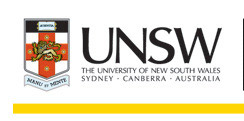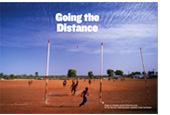As a large land mass with a small population at the bottom of the world we Australians have often been obsessed with conquering distance. Australia may be the world’s smallest continent, but it is a continent that is the whole nation – or in the famous phrase, “a continent for a nation and a nation for a continent.” Australia is also world’s largest island with vast distances to travel within and beyond our shores. It is this obsession with distance that has made Australians think so much about transport and infrastructure. Shipping lines and freight rates matter so much not just to exporters and importers but to the whole Australian nation; the advance of air travel really benefitted Australia (the large 747 jumbo jets caused a revolution for our tourism industry and immigration), and there are constant debates in public policy about new roads and rail links not to mention the odd bit of chatter about a second airport in Sydney.
Australia’s obsession with distance was intellectually brought to the fore of our national psyche when the famous economic historian Professor Geoffrey Blainey wrote his ground breaking book The Tyranny of Distance in 1966. Blainey covered, the length of time it took ships to bring supplies to the early convict colonies of New South Wales and Van Diemen’s Land (Tasmania), the importance of whaling in the early days of the Australian economy, how we moved the whole clip around the world and the impact of transport from Cobb and Co horse and cart around the gold fields and the sailing in the 1850s to the introduction of the passenger liner, the steam train and the motor car in later years (even before the dawn of aviation).
But in when Geoffrey Blainey reflected on his seminal work The Tyranny of Distance, he opined:
“Sometimes I think people take the phrase further than it should have been taken and certainly than the book intended. My book is essentially about people and commodities, and for them the cost of distance has actually been high. But for ideas the freight has often been cheap. In the history of this land, ideas have usually leaped with relative ease across the ocean and even across inland.”
As Blainey notes, the capacity of Australia to engage in the world of ideas has been cheap relative to the cost of transporting physical goods across the globe. But even in the world of communications, we’ve seen mini-revolutions that have helped Australians engage with the world of commerce and the whole global community. And trade and investment has been an integral part of the different waves of development in communications that has brought the world closer to Australia and in turn Australia closer to the world.
In the first wave, back in the nineteenth century, Siemens helped open up the outback by providing the technology and infrastructure to allow the Adelaide to Darwin telegraph to be completed thereby linking Australia with London and therefore the world.
In the second wave, in the twentieth century, we saw the advance of short wave radio, television, and other advances to accompany the great leaps in transport infrastructure so familiar to us all. Further advances were made in satellite technology which accelerated the pace of communications further.
In the third wave, as the twentieth century gave way to a new century and a new millennium, the information age and the introduction of the internet, e-commerce and digital technologies allowed a whole new generation of exporters – particularly those in rural and regional Australia – to engage in the global market place. For example, Mary Nenke, a Yabbie grower in Kukerin in the WA wheat belt, set up a website to sell her produce to Perth and ended up getting orders from Hong Kong, Singapore and the USA and ‘accidentally’ became exporter of the year. And she wasn’t alone, according to Austrade/ABS research at the time, 50 per cent of all exporters were ‘accidental’ as the advance of ecommerce made it possible to market to the world. Even if you produced Yabbies in a little country town in WA, the world became your oyster.
Now we have the latest advance in communication with the roll out of the National Broadband Network (NBN) which as all the potential of the previous waves to reduce the time and cost of exporting, and then some. And the NBN has been rolled out first in Tasmania and other parts of regional Australia. Like in the previous revolutions a small exporter on the remote North West Coast of Tasmania will now be able to easily connect with Norway, and a South Australian wine grower will be able to connect with his business partner in Santiago. The NBN will also allow rural communities to better engage with the counterparts in regional towns and cities in commerce and education. The NBN will open up small communities to the world just as Siemens helped open up the outback in the nineteenth century.
As Australians we have been obsessed with planes, trains and automobiles and other forms of transport and infrastructure. It’s not a surprise given our geography and our history and our very practical hands on nature. But as Geoffrey Blainey said, it is the transfer of ideas that makes the world go around and creates prosperity across nations. So the NBN is the latest chapter in Australia’s proud history of conquering distance and using the latest source of global innovation to suit our comparative advantage.
*Tim Harcourt is the JW Nevile Fellow in Economics and an adjunct professor in International Business Strategy at the Australian School of Business at the University of New South Wales (UNSW) in Sydney. He is also the author of The Airport Economist www.timharcourt.com.













No Comments so far ↓
Comments are closed.